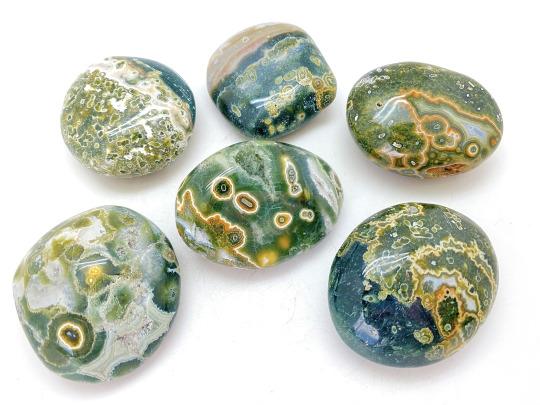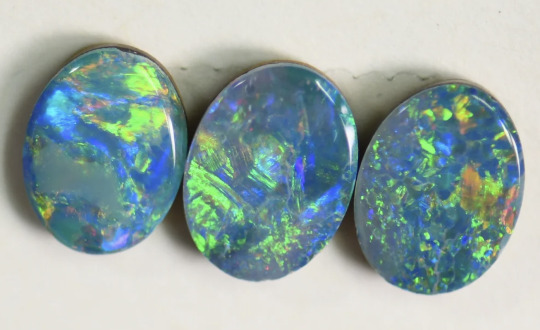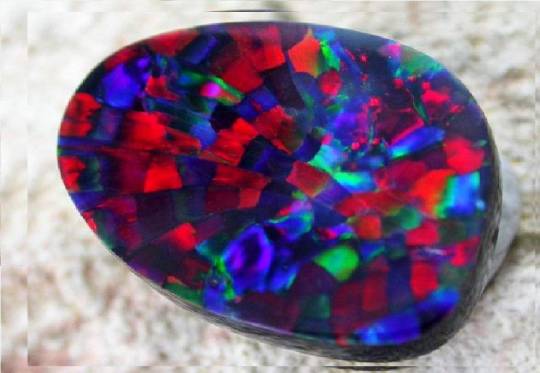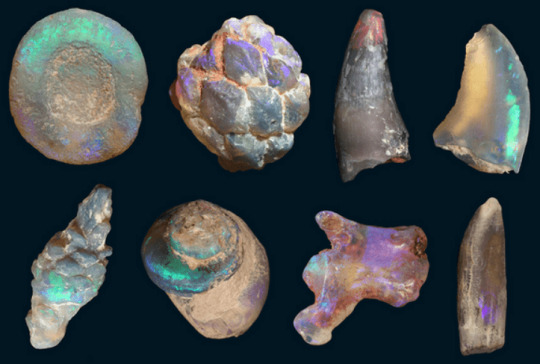#mineral swag prelims
Explore tagged Tumblr posts
Text
Preliminary Poll - Chalcedony
Agate and Jasper and Chalcedony, oh my!
This poll was originally going to be 2 separate polls distinguishing agate and jasper, but here's the thing. Agate and jasper are both chalcedony with very little to distinguish them except opacity vs translucency. Also, 2/3 agate submissions are not true agates because they don't have banding. So instead of having two polls, the top TWO chalcedony varieties from this poll will be entered into the competition.
With that, here are the competitors:





More information under the cut!
Chalcedony is cryptocrystalline silica. This means that it has a crystalline structure, but even at the microscopic scale, this structure is difficult to make sense of. Similar to opal, it is basically a fucked up quartz, and agate and jasper often have quartz along with chalcedony anyway.
Ocean jasper is a blue and green colored jasper that is found in Madagascar. It is opaque, which is partially what distinguishes jasper from other chacedony varieties like agate.
Bloodstone/heliotrope is a green jasper with small red dots that look quite a bit like blood splatters. However, they are just iron oxide (like rust).
Lake superior agate is white and red banded chalcedony and its bands are what make it an agate. It is found in many midwestern US states, especially those on the shores of Lake Superior. Its red color is due to iron staining (the same stuff that makes the red dots in heliotrope red)
Grape agate or grape chalcedony is not actually an agate at all! It is just chalcedony/microcrystalline quartz spheres with a botryoidal habit, which literally means it looks like a bunch of grapes! One of my top five favorite minerals, prehnite, also typically forms botryoidal clusters.
Moss agate is once again not an agate but chalcedony. It is usually white or clear with these green inclusions that look like little bunches of moss.
As always, any questions or additional information is always welcome!
49 notes
·
View notes
Text
Preliminary Poll - Quartz Varieties



More information and images under the cut!
Quartz is such a versatile mineral, especially when you add all the weird cryptocrystalline silica minerals into the fold.
Here we have several colorful varieties of quartz. Ametrine is a combination of amethyst (purple quartz) and citrine (yellow quartz). These colors in quartz are due to very small changes at the atomic level. These changes are not nearly significant enough to change the chemical formula of quartz (for a discussion on what changes ARE big enough to affect the chemical formula and create different mineral species, check the read more on the tourmaline poll). Instead, to get different colors of quartz there are just a few atoms where they shouldn't be.
The purple color of amethyst AND the yellow color of citrine are both due to iron impurities, so it makes sense that quartz samples would sometimes have both colors. I didn't know about ametrine until I got this submission, but I do enjoy it because purple and gold were the colors of the university I attended for undergrad.


I always was told that the pink color of rose quartz is mostly from manganese, but it can also be titanium or iron impurities. Rose quartz can also have asterisms, which are star shaped light refractions in polished samples.


In a brief search, I couldn't find anything substantive about why chevron amethyst forms in a chevron shape, but from what I know of mineral "zoning," I imagine the pattern is due to layers of quartz with different mineral inclusions being deposited one by one over time.
In my humble (asexual-identifying) opinion, I think the most important thing about chevron amethyst is that sometimes the layers are dark smoky quartz layers, and the purple, white, and grey layers look like the asexual/demisexual flag.


32 notes
·
View notes
Text
Preliminary Poll - Opal Varieties




More information under the cut!
Opal! Opal is technically NOT a mineral because it lacks one of the defining traits of minerals - a specific, ordered internal structure. Opal is amorphous, so the atoms are arranged randomly, they don't have a pattern to them that would make opal a mineral!
Chemically, opal is hydrous silica. Something fun about the preliminary polls is that aside from tourmaline and jade, all the other minerals included are essentially variations of quartz, which is really just silica. The chemical formula for quartz is SiO2 and the chemical formula for opal is SiO2 with H2O.
Opals in general are known for their iridescence (the shiny colors that change when you rotate an opal in your hand). This iridescence happens BECAUSE opal is not a mineral; the random internal structure makes it so that light reflects in all kinds of crazy ways.
About the listed opals themselves, Australian opals are the most common, because most opal comes from Australia. Australian opal is probably what most people think of when they think of opal: shiny, with bright pastel colors.
Ethiopian opals, meanwhile, tend to have more fiery colors (think fire opals) and are also hydrophane which means they absorb water.
Harlequin opals are opals where the iridescence looks like geometric shapes. Unfortunatly, I don't know what is happening on the microscopic level that creates these rhombohedral shapes in harlequin opals. Most of the information I'm sharing in these posts is stuff I already know from the classes I had to take in undergrad, or introductory-level facts that I've been able to summarize from Wikipedia pages or Mindat.org pages. That being said, I'm always willing to learn from people who know more than me or to do more of my own research if people have questions and aren't sure where to start looking (hint: Wiki and mindat are great places to START your research, regardless of what high-and-mighty teachers might say).
Lastly, opalized fossils are fossils where the organic material from a previously living organism is replaced by silica (in this case, specifically opal). Most often, fossils form when minerals of some kind (silica, carbonates, pyrite, etc) fill in the empty spaces of a dead organism, like the inside of a snail or bivalve shell. The opalization of fossils is only one way this process, called permineralization, can occur, but it sure is pretty!
26 notes
·
View notes
Text
Preliminary Poll - Tourmaline Varieties




More information and images below the cut!
Tourmaline is a mineral with a lot of varieties. Tourmaline in general has a consistent chemical formula, but certain spots within that formula can have different elements that make different "species" of tourmaline.
A more simple example we can use to understand how this works is olivine (aka peridot)! Olivine has two prominent "end members" or mineral species. The chemical formula for olivine is
(SOMETHING)2Si2O6
That (SOMETHING) is almost always magnesium (Mg) or iron (Fe) or some combination of the two. If an olivine sample has ALL magnesium in that spot, it is known as forsterite (one of the olivine "end members"). If it has ALL iron in that spot, it is known as fayalite (the other end member). And, of course, because nature is not perfect, there can be an olivine with any combination of mangesium and iron (between these two end members).
At their core, fayalite and forsterite are both olivine. They are both silicate minerals (see the part of their formula with Si) and regardless of whether they have magnesium or iron, their structure is the same. They have silicate tetrahedrons (the 3D shape that the molecule Si2O6 makes - think a d4 in D&D) bonded with some iron or magnesium atoms.
The same is true of TOURMALINE! The chemical formula for tourmaline is much longer and has a lot more room for elemental substitutions, but the idea of the different tourmaline species is the same as the two olivine species. Different elements at certain spots in the formula make varieties of tourmaline.
Elbaite is one such tourmaline species. It has lithium in the first replaceable "spot" of the chemical formula. Above, we have a blue to purple gradient elbaite. We also have verdelite and watermelon tourmaline, both different colored elbaites. Note that the color variation in the blue-purple elbaite happens vertically, while the color variation in the watermelon tourmaline happens concentrically. Below, I have two more images of elbaite from the university museum I worked at. One is a pretty big (about one foot wide in any direction) sample with a green-blue-purple gradient, and the other is a small (a couple inches tall) dark pinkish sample.


The color variation between elbaite samples is due to single atoms in the crystalline structure being replaced by others. Mineral species have almost/all of one element replaced by another across the crystal structure. These are widespread changes that are indicated in different chemical formulas. Different colored minerals of the same species have very very few atoms replaced. Considering how many single atoms make up a mineral so big that you can see it, this is a very small change.
Schorl, meanwhile, is a different tourmaline species. In the chemical formula for tourmaline, where elbaite has lithium, schorl has sodium and iron instead.
Tourmaline, regardless of species, is a cyclosilicate mineral and that is why we see tourmaline as these long cylinders. This macroscopic shape that we can see is a direct reflection of how the crystalline structure looks at a microscopic level! When combined with the bright colors of elbaite samples, it just looks like candy!
28 notes
·
View notes
Text
Preliminary Poll - Jade Minerals


More information and images under the cut!

The material we know as "jade" is actually two different minerals - jadeite and nephrite! Both are most often green but come in many shades of whitish-yellowish-blueish-greenish colors.
Jadeite is a pyroxene mineral. It is most known for the "imperial green" color (pictured below). Jadeite is more rare than nephrite and has a slightly higher hardness. Meanwhile, nephrite is an amphibole mineral.

Pyroxene and amphibole are most often black igneous minerals (i.e. pyroxene and amphibole crystals form as magma cools and forms igneous rocks) with similar melting points, but pyroxene has a squat blocky structure, and amphibole has elongated crystals.
I'll do my best to answer any questions y'all have about these minerals!
25 notes
·
View notes
Text
Preliminary Polls!
As previously discussed, several varieties of different minerals were submitted to the competition. In order to keep the number of minerals at 64, there will be 5 preliminary polls!
Jasper and Agate Varieties
Quartz Varieties
Opal Varieties
Tourmaline Varieties
Jade Minerals (these are 2 distinct minerals, not species of the same mineral)
Also included in each of these posts is bonus information about the minerals and additional pictures! You are under no obligation to read the extensive amount of mineralogic information and have it sway your opinion because of the cool properties these mineral varieties might have, but if you want to learn about these sick ass minerals, I hope you enjoy!
Additionally, for the sake of transparency and citing my sources, almost all of the information I provide is what I learned in my geology classes in undergrad or from basic research on sites like Wikipedia and Mindat.org. Neither of these sites are perfect, but I have always found they are a phenomenal place to start introductory research.
I didn't include citations for the pictures. I hope you can forgive me.
Thanks again for following this blog and for wanting to vote on rocks!
15 notes
·
View notes